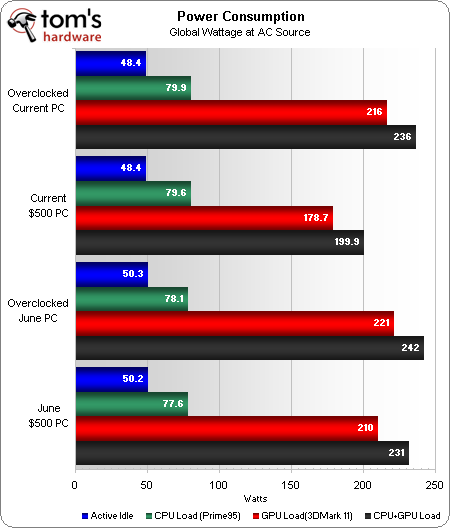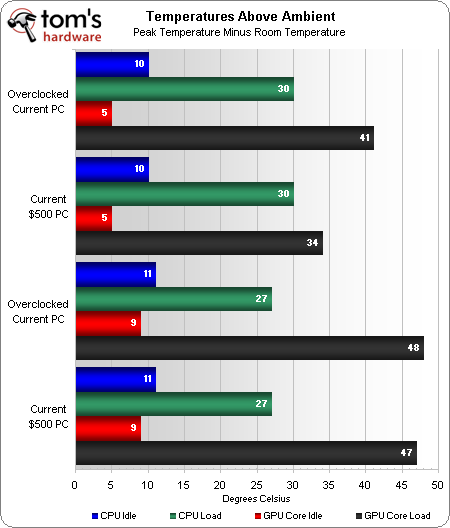System Builder Marathon, August 2012: $500 Gaming PC
Power Consumption And Temperatures
We enabled power-saving features on both rigs and didn’t override automatic fan controls during testing. In effect, we traded higher core temperatures for quieter fan operation.
Both systems are driven by the same Antec VP-450 power supply, which offers respectable efficiency, despite the fact that it lacks an 80 PLUS certification.
Although idle consumption was only 50.2 W last quarter, and 50.1 W back in June of last year with a Core i3-2100 and Radeon HD 6850 under the hood, this marks the first time our budget gaming PC pulls less than 50 W from the wall. Outfitted with a higher-clocked Pentium processor, however, today's rig consumes 2 W more at 100% processor load than our previous efforts.
MSI's GeForce GTX 560 reaches a respectable 950 MHz core frequency after a voltage bump to 1.050 V, though that results in a substantial increase in peak power consumption under 3DMark 11.
While the performance of Intel’s bundled heat sink isn't impressive, it does offer quiet operation and adequate cooling for our multiplier-locked processor.
MSI’s dual-fan thermal solution effectively cools the overclocked and overvolted GeForce GTX 560, never ramping up past 53% duty cycle. We also have to keep in mind the greater interior volume of today’s enclosure. Bottom line: GPU temperatures were of little concern on either build, as both GeForce cards had cooling to spare.
Get Tom's Hardware's best news and in-depth reviews, straight to your inbox.
Current page: Power Consumption And Temperatures
Prev Page Benchmark Results: Productivity Next Page Performance Summary And Efficiency-
crisan_tiberiu so, looks like 500$ (Euro in europe :P) its enaugh to play any modern game that is trown on the market... ty consoles :PReply -
itzsnypah I think it would be interesting if next quarter for your Budget PC you try to bring the performance per watt as high as you can while still maintaining an enjoyable gaming experience. Something like a G620+HD7750/70 with a high efficiency PSU such as Rosewill CAPSTONE 450.Reply
Ever since I read the 7950B/7970GE review on here/anand performance per watt for me has been a priority when selecting components. -
mayankleoboy1 ReplyI think it would be interesting if next quarter for your Budget PC you try to bring the performance per watt as high as you can while still maintaining an enjoyable gaming experience. Something like a G620+HD7750/70 with a high efficiency PSU such as Rosewill CAPSTONE 450.
On the contrary, for a 500$ build, energy consumption and heat should be least concerns. Tweaking, overclocking and extracting the last possible performance from your hardware are the primary concerns of a 500$ gaming build. Even after HEAVY overclocking, you wont get 50W over the stock settings. -
sam_fisher mayankleoboy1On the contrary, for a 500$ build, energy consumption and heat should be least concerns. Tweaking, overclocking and extracting the last possible performance from your hardware are the primary concerns of a 500$ gaming build. Even after HEAVY overclocking, you wont get 50W over the stock settings.Reply
One may presume that someone after a $500 build is on a budget and hence doesn't want higher power consumption from overclocking.
-
yyk71200 Well, considering that I already have 3570K with GTX570, I'll be interested only in either $2000 PC or a graphic card from a $1000 PC.Reply -
itzsnypah mayankleoboy1On the contrary, for a 500$ build, energy consumption and heat should be least concerns. Tweaking, overclocking and extracting the last possible performance from your hardware are the primary concerns of a 500$ gaming build. Even after HEAVY overclocking, you wont get 50W over the stock settings.According to the performance summary and efficiency page of this article Overclocking the GPU had a 13%(average according to this article) increase in power consumption for an extra 2% (average) performance. That seems like the opposite thing I'm talking about.Reply
Overclocking is good for performance per dollar, not performance per watt. -
abegnale @Paul Henningsen,Reply
Why not substitute some existing parts for either an I3-2100 and/or an eVGA 560 Superclocked? -
giovanni86 Nice, looking forward to the next builds. Some times OC does yield its advantages, those few frames can help and have helped me in games running smoothly or just over 30FPS. I honestly don't see why people are concerned with power, PC's don't cost much to run even overclocked. Unless your poor or working at McDonald's, then i see no reason why power is an issue unless otherwise stated. This whole green thing is a pain in the ass. I'm power hungry sorry.Reply


